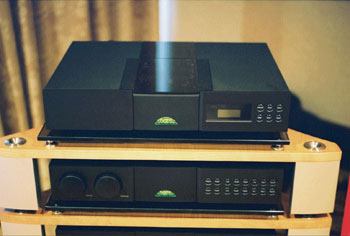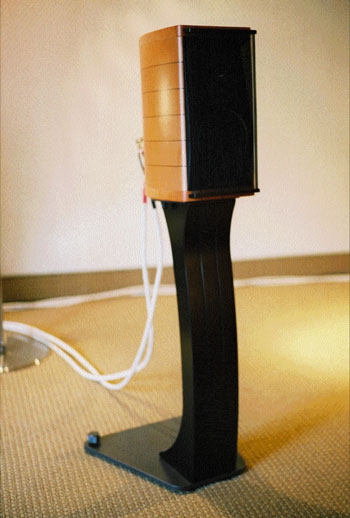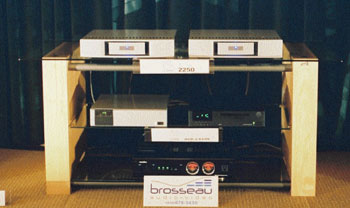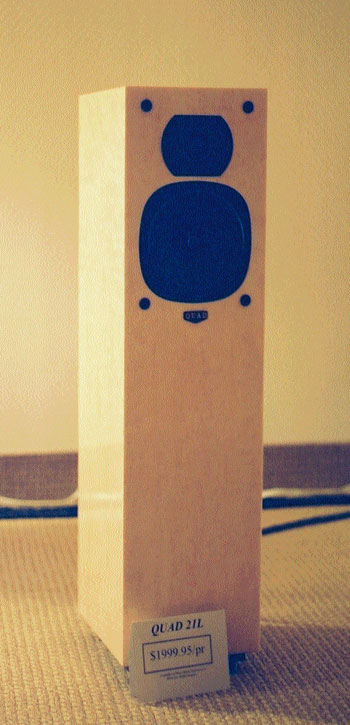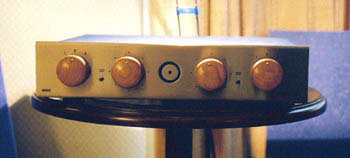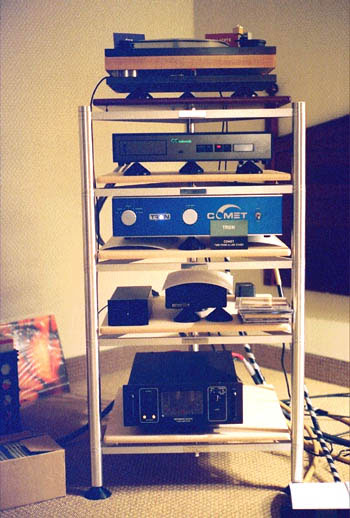|
You are reading the older HTML site
Positive Feedback ISSUE 6 Le Festival Son & Image Montreal, Canada, March 28-30, 2003
Introductory Remarks For those of you who have never been to an audio show, a few introductory remarks. 1. Hotel Rooms are difficult places to demo audio gear accurately, not so much because they tend to be small (which to be honest many of our listening rooms are too) but because they must be essentially emptied out to make room for the audience. And because they come with bare walls. Unless the demonstrators take considerable pains, these near-empty modest sized rooms can become Sound Hells. Some demonstrators are pros at dealing with this—and also at choosing equipment from their lines this is suitable for such peculiar spaces. If their gear is good to begin with, it will tend to sound good here and I heard several examples of this. Other demonstrators seem clueless about how to adapt to the limiting circumstances and in those cases, no matter how good their gear was, it tended to sound awful—in some cases god-awful. 2. System Matching. For reasons beyond my ken, perhaps practical ones, some demonstrators hook their gear up with other companies' gear in ways that yields… well let's just call it discord. If you are a shrewd listener and are motivated to do so, you can sometimes hear through the mismatches to the quality of a particular component buried in the mix. My advice, which I have tried to follow in my report below, is that it is best not to draw conclusions about any specific piece of equipment buried in one of these systems. The only really good sounding systems at the show were those where the principal product exhibitor controlled the whole system, either by being the designer of all the parts or by pairing gear with other gear he knew matched his own well. I heard several very expensive combinations of equipment that if taken seriously would have put all of the manufacturers contributing to the resulting cacophony out of business!3. Boom-boom, tinkle-tinkle. A great many demonstrators seem convinced that the audience at audio shows are more interested in sound than music and that they have no interest in classical music. They may, of course, be right about this! But the result is that emanating from room after room comes not the sound of a violin or piano or orchestra but boom-boom, tinkle-tinkle, blare-blare (translation: our gear can do bass, treble, and dynamics); or the voice of Norah Jones and/or Diana Krall. So if you go to a show to find out if a particular piece of equipment or system can actually play music, you take your own CD's. I took some violin and harpsichord sonatas by Bach, a Haydn symphony, some violin and piano music by Stravinsky, and some Mahler. To my ears, these recordings, though they often humbled systems geared up for more dynamic and/or luscious fare (and thinned the audience rapidly), did a fine job at sorting the authentic music-makers from the pretenders. 4. Camaraderie. You are unlikely to find better company among fellow audiophiles, designers, audio-shop proprietors, and even—god forbid—reviewers, anywhere on the planet. Okay, to the news. I have just gotten back the photographs I took with a new camera and using available light, and I apologize for the relatively dim view they provide of the goods at hand. Some of the ones I had the highest hopes for came back utterly gray. That's what PF gets for sending an amateur to do a pro's work.
I was very eager to hear the new Naim CDS3, successor to my reference CDS2. I got to hear the first one to arrive in North America and was impressed. It was playing in an all-Naim system—and not even the new top-of-the-line gear one would have expected. It struck me as very satisfying and, as always with Naim sources, exciting. The system grabbed Monica Huggett's violin, body and strings, more firmly, clearly, and eloquently than I have heard it lately. Ton Koopman's resonant harpsichord was clear, resonant, and totally under control as it frequently is not coming through players with a less sure grip on the bottom. I know that Naim has spent a great deal of time working to get the "3" right: that is, to keep the virtues of the "2" while moving toward a presentation that meets the expectations of those outside the World of Naim as well. I approve of this move, though there will doubtless be some who prefer the sound of the CDS2. Naim folks tend not to like change and are sometimes right to drag their feet. In several visits to this room I developed the impression that Naim has executed this change well, but I look forward to checking my impressions on my own system a month or so from now. My overall impression from this audition is that the CDS3 is somewhat more open and detailed than the CDS2, and I know that this has been the design goal. Note: a new CDX2 was playing in another room in an all-Naim system feeding Royd and Neat speakers and also sounded very promising.
I have not heard a Sonus Faber speaker in a long time and was happy to have an opportunity to hear the new Cremona Auditor stand-mounted speaker and to meet Patrick Butler, with whom I have been emailing ruthlessly over the course of a year or so in my pursuit of a review pair of Sonus Faber Guarneri's (!) Patrick was one of those precious few who seemed to know which speakers his hotel room would respond well to and his system, though arguably not ideally matched with the Classe electronics provided (I assume, by the local SF dealer), was one of the best I visited. The Auditors nailed the midrange of the Haydn symphony I fed it. Patrick had a sub hooked up to the Auditors but I enjoyed the Auditors quite well without it.
Linn was one of the rooms which, thanks to the breadth of their product line, was able to control their whole system, and this paid obvious dividends. A Linn Ikemi, Kairn, pair of 2250's in active mode, and Ninka speakers made all of my CD's sound musical and satisfying. I would call the system more appealing than revealing, but I am not drawn to overly euphonic sounding systems and I happily returned to the Linn room several times. The audience in the Linn room liked my Huggett/Koopman recording!
The new Quad 21L dynamic speakers, floor standing versions of the popular 11L's sounded very, very good in an all-Quad system that included their 99-CDP CD player and 909 integrated amplifier. If you could take the room out of the equation, I could have raised the rating to superb. Clearly this is a new direction for Quad, embarked on with care and I'm sure, some trepidation. They needn't have worried. All of my CD's sounded very satisfying. A fine example of a system of mixed brands assembled lovingly and wisely included a Creek CD53 digital source, Creek 5350SE integrated amplifier, and Visonic Concept 3 speakers from Germany. This was one of the best sounding systems in the show for me, and it demonstrates how show experience and judgment about component matching can pay off. A very natural sound, absolutely without artificial warmth and with no hyped upper mids either. Modest and involving compared with many systems I heard that aimed for more and achieved far less. (Sad to say, my photo of this system came out gray.)
One of the best sounding rooms, which I am duty bound to recognize on its merits despite my new connection with the demonstrator, was another of those in which the demonstrator clearly knew how to match equipment and turn the limitations of the room to his advantage. Using an Audomeca digital source (for which they have become the Canadian distributor) and Martin Logan speakers, which have been the designer's reference for years, Blue Circle offered one of their modest tubed preamplifiers, the BC21.1 and new hybrid stereo amplifiers, the 120 watt BC28. The system as a whole was among the most engaging and musical I heard. Also hiding off in a corner was a new all-solid-state BC103 preamp promised for sometime later this year. It made a brief appearance in the system toward the end of the show and turned a hopeful head or two playing the Stravinsky CD.
I spent a good deal of time in a room featuring a Tron Comet tubed preamplifier, David Berning ZH 270 amplifier, and floor-standing Merlins. The source was a now superceded Naim CDX. This was my prime example of a system that seemed to exhibit enormous promise but which was robbed of its potential by a lack of synergy among the components. Though it sounded close to perfect on analogue (the turntable is a DPS turntable from Germany) and nearly nailed my Huggett/Koopman CD, it seemed somewhat hard-shelled on digital material overall. The Naim and Merlin each contributed a touch of insistence to the mix that as a whole was generally more than the reportedly utterly neutral Berning and slightly warmer Tron Comet could counterbalance. I would like to have heard this system with a more appropriate digital source because the Tron, Berning and Merlin were clearly very happy together, a surprise given how often the latter is heard with warmer tube amps. I found myself listening through the lack of synergy in this room from time to time and heard enough good sound to make it worthy of mention. I also spent time in a room featuring Manley electronics and Beauhorns, which sounded convincing on analogue material but a little too crisp on digital, thanks apparently to a new CD player called a Stella, which was singing a somewhat different tune than its companions. I have the impression that digital and horns are not a match made in heaven but will keep my mind open on this one. There was a promise to insert an Audio Research CD3 into the system later in the day, which alas, was not kept. The Manleys were, of course, lovely to look at. This report is clearly not intended to be comprehensive or definitive. In true Positive-Feedback Online tradition, I see no reason to pillory the many systems I heard that suffered from a combination of the problems I cited above. I know from experience that much of the equipment that sounded profoundly unsatisfying at this show is in fact very good sounding equipment. The fact that some major names are missing from this brief survey can be attributed in part to my not wanting to criticize unfairly. There were also a few marques conspicuously absent—Harbeth and Reynaud speakers in particular. Both would seem to fit well into a show like this and I hope they will consider visiting Montreal in the future. Bob Neill is a part-time retail dealer for Blue Circle Audio. |

